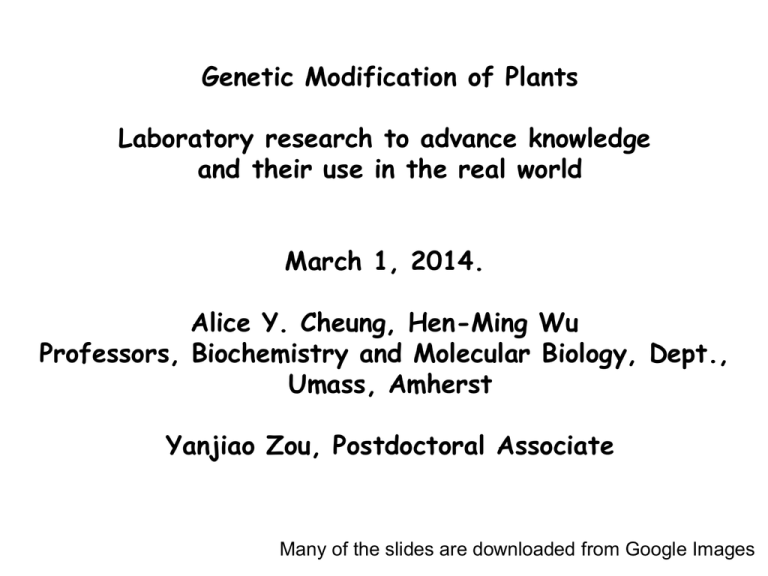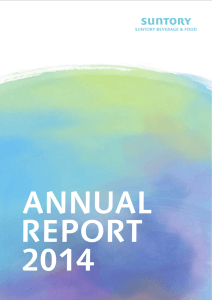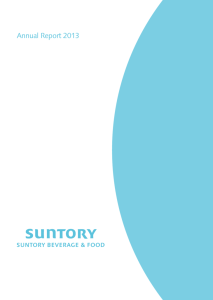
Genetic Modification of Plants
Laboratory research to advance knowledge
and their use in the real world
March 1, 2014.
Alice Y. Cheung, Hen-Ming Wu
Professors, Biochemistry and Molecular Biology, Dept.,
Umass, Amherst
Yanjiao Zou, Postdoctoral Associate
Many of the slides are downloaded from Google Images
How to generate genetically modified plants?
a potential high school classroom module
•The standard method: Agrobacterium Ti plasmidmediated plant transformation (9:00 am)
•The exercise – the work from two summer interns (9:45 am)
•Genetic analyses of transformed plants (a teacher
and student exercise) (10:15am, in LGRT1105, Dr. Zou)
•Break (10:15 am), Q @ A (during break and 11 am,
after class reassembles)
•Some examples – Golden Rice; Blue Rose
•The start of RNA interference (RNAi) [the work led
ultimately to a Nobel prize for work done in worm]
A step-wise summary of the method
1. Determine the gene of interest to be introduced and generate the necessary
recombinant DNA molecule: this involves basic DNA cloning technology, such as (1)
DNA isolation, (2) gel electrophoresis, (3) use of different enzymes to create the
recombinant DNA. This step is carried out in the most commonly used lab
bacterium, Escherichia coli (E. coli).
To express the gene,
i.e. to make the product of
interest
For experimental examples, we’ll use a pollen-specific promoter (LAT52);
we’ll use b-glucuronidase (gives a blue color); green fluorescent protein (GFP)
and red fluorescent protein (RFP) as our genes of interest.
2. Introduce the recombinant DNA from E. coli into Agrobacterium (the agent that
transforms plant, i.e. genetically modify, plants; this involves (1) basic
microbiological techniques: (2) DNA isolation; (3) DNA characterization by
polymerase chain reaction (PCR).
Agrobacterium is a plant pathogen: it causes “crown gall disease”,
e.g. on grapevines
The Agrobacterium Ti plasmid system
The Agrobacterium Ti plasmid system
The Agrobacterium Ti plasmid system – a “vehicle”, a “vector
To introduce foreign DNA into plant cells –mid to late -- 70’s
Inducer made by plant:
acetosyringone, induces
T-DNA excision
The Agrobacterium Ti plasmid system – a “vehicle”, a “vector
To introduce foreign DNA into plant cells –mid to late -- 70’s
Introducing your gene of interest into plant cells
Gene for selection: e.g. antibiotics resistance,
Herbicide resistance
3. Transform plants: Use model plants in the lab. Tobacco is the more traditional
plant used, and was most important in earlier studies to work out the
transformation method. Arabidopsis is the most commonly used model plant.
The principle is the same, the methods are very different. From start to finish will
take about 4 months (Arabidopsis) to 6 months (tobacco).
The Agrobacterium Ti plasmid-mediated
transformation – an overview
Selection:
Transformed plants
Survive;
Non-transformed ones
died
Tobacco leaf disc transformation
Jason DeFuria and Norice McGrath’s summer ‘13 internship
Jason and Norice making leaf discs
Go to video
After the transformation step:
4. Selecting transformed plants [transformation event is very low, need a way
to identify the transformed plants/cells from the non-transformed ones.
Gene for selection:
e.g. antibiotics resistance,
Herbicide resistance
One month later, on kanamycin-containing
medium to select for transformed plants
Grown in soil in the lab, one month
In the greenhouse, takes about three months
to flower; pictures show a high school student
from a couple of summers ago, collecting seeds
(she is now a first year student in
Carnegie-Mellon University)
Arabidopsis transformation by floral dip
Show video, Norice preparing the plants, Jason preparing the dunking medium
Jason and Norice’s plants
Select transformed seedlings
on kanamycin containing medium
Jason and Norice’s
5. Genetically characterize the transformed plants: this can be done in different
ways to determine the presence of the transgene and its inheritance (basic genetic
characterization -- Mendelian principles). We can use visual characterization, e.g.
using resistance to kanamycin – easiest. Or we can use molecular analysis, by PCR.
These are second generation seedlings, the green plants inherited the transgene,
the white ones did not
6. Analyze transgenic plants.
An example, we have introduced “the blue color” gene into the plant.
Pollen Tubes
Apical vesicular
zone
Subapical
actin
Cheung and Wu, 2008 Ann. Rev.
Plant Biol;,
Cheung et al., 2010. PNAS
High school teacher summer internship
Sponsored by the NSF support Research Coordination Network on
Integrative pollen biology
http://pollennetwork.org/
A stipend is provided.
Contact Alice Cheung
acheung@biochem.umass.edu
Golden Rice
White rice – lacks vitamin A; a major health problem
Genetically engineer vitamin A accumulating
rice grains.
Provitamin A biosynthetic pathway.
Beyer P et al. J. Nutr. 2002;132:506S-510S
©2002 by American Society for Nutrition
Blue Rose
Suntory Creates Mythical Blue (Or, Um,
Lavender-ish) Rose
http://www.popsci.com/science/article/201109/suntory-creates-mythical-blue-or-umlavender-ish-rose
Generalized flavonoid biosynthetic pathway relevant to flower color.
Katsumoto Y et al. Plant Cell Physiol 2007;48:1589-1600
© The Author 2007. Published by Oxford University Press on behalf of Japanese Society of Plant
Physiologists. All rights reserved. For permissions, please email:
journals.permissions@oxfordjournals.org
Fig. 1 Generalized flavonoid biosynthetic pathway relevant to flower
color. Native rose petals only accumulate pelargonodin and
cyanidin-based anthocyanins, mainly pelargonidin and cyanidin 3,5diglucoside. Lack of delphinidin-based anthocynanins, which is
attributed to deficiency of F3050H, has hampered the generation of
rose flowers having blue and violet hues. The expression of a
hetelorogous F3050H gene in rose is expected to generate
delphinidin and, thus, a novel flower color with a blue hue. CHS,
chalcone synthase; CHI, chalcone isomerase; F3H, flavanone 3hydroxylase; F30H, flavonoid 30-hydroxylase; F3050H, flavonoid
30,50-hydroxylase;
FLS, flavonol synthase; FNS, flavone synthase; DFR, dihydroflavonol
4-reductase; ANS, anthocyanidin synthase; GT, anthocyanidin
glucosyltransferase; AT, anthocyanin acyltransferase.
Schematic representation of binary vectors constructed for color modification.
Katsumoto Y et al. Plant Cell Physiol 2007;48:1589-1600
© The Author 2007. Published by Oxford University Press on behalf of Japanese Society of Plant
Physiologists. All rights reserved. For permissions, please email:
journals.permissions@oxfordjournals.org
Fig. 2 Schematic representation of binary vectors constructed
for color modification. Only some T-DNA regions are shown.
The
directions of the cDNA sense strand are shown by arrows. All of
them have the nptII gene as the selectable marker for plant
transformation.
E35S Pro., enhanced CaMV 35S promoter; mas Ter., terminator
region from manopine synthase; nos Ter., nopaline synthase
gene
terminator; D8 Ter., terminator region from a petunia
phospholipid transfer protein gene (D8) (Holton 1996); F3050H,
flavonoid
30,50-hydroxylase; DFR, dihydroflavonol 4-reductase; 5AT,
anthocyanin 5-acyltransferase.
Flower color changes by delphinidin production.
Delphinidin
WKS77
0
1.068
WKS 82
WKS116 0
0.051
WKS124
0
0
0.139
WKS100
0
1.017
WKS 140
0
Katsumoto Y et al. Plant Cell Physiol 2007;48:1589-1600
© The Author 2007. Published by Oxford University Press on behalf of Japanese Society of Plant
Physiologists. All rights reserved. For permissions, please email:
journals.permissions@oxfordjournals.org
0.152 mg/g
0.114
Fig. 3 Flower color changes by delphinidin production. The rose
cultivars WKS77, WKS82, WKS100, WKS116, WKS124 and WKS140
were transformed with pSPB130, and their flower color changed
(left, host; right, a transformant). A flower of the line exhibiting the
most
significant color change is shown. (A) WKS77, (B) WKS82, (C)
WKS100, (D) WKS116, (E) WKS124, (F) WKS140.
Correlation of delphinidin content and petal colors in transgenic Lavande.
Katsumoto Y et al. Plant Cell Physiol 2007;48:1589-1600
© The Author 2007. Published by Oxford University Press on behalf of Japanese Society of Plant
Physiologists. All rights reserved. For permissions, please email:
journals.permissions@oxfordjournals.org
Northern blot analysis of LA/919-4-10.
Katsumoto Y et al. Plant Cell Physiol 2007;48:1589-1600
© The Author 2007. Published by Oxford University Press on behalf of Japanese Society of Plant
Physiologists. All rights reserved. For permissions, please email:
journals.permissions@oxfordjournals.org
Delphinidin contents of the transgenic progeny.
Katsumoto Y et al. Plant Cell Physiol 2007;48:1589-1600
© The Author 2007. Published by Oxford University Press on behalf of Japanese Society of Plant
Physiologists. All rights reserved. For permissions, please email:
journals.permissions@oxfordjournals.org
Suntory Creates Mythical Blue (Or, Um,
Lavender-ish) Rose
http://www.popsci.com/science/article/201109/suntory-creates-mythical-blue-or-umlavender-ish-rose
Suntory to sell blue roses overseas
Kyodo
•Sep 16, 2011
The world’s first blue roses will hit stores in the
United States and Canada in early November,
with the aim of selling 300,000 of them in
2012, said its developer, Suntory Flowers Ltd.
The flowers will be sold under the brand name
“Applause” by selected florists in North
America. They first hit stores in Tokyo in 2009
for ¥2,000 to ¥3,000 each and became popular
gifts, the subsidiary of beverage maker Suntory
Holdings Ltd. said.
After selling 50,000 of the roses in 2010, the
firm expanded sales across Japan, except for
Okinawa Prefecture, last January, it said.
http://www.telegraph.co.uk/news/worldnews/asia/japan/3329213/Worlds
-first-blue-roses-after-20-years-of-research.html
World's first blue roses after 20 years of research
The world's first blue roses have been unveiled following
nearly two decades of scientific research.
The start of the road to RNAinterference – a Nobel Award winning work
2006 Nobel Prize -- RNAi











